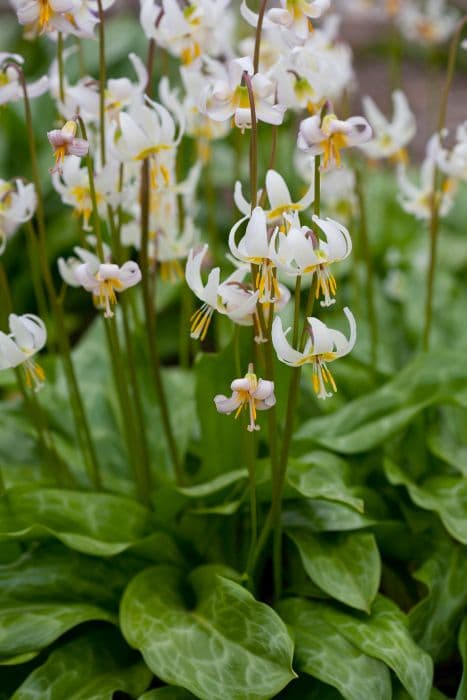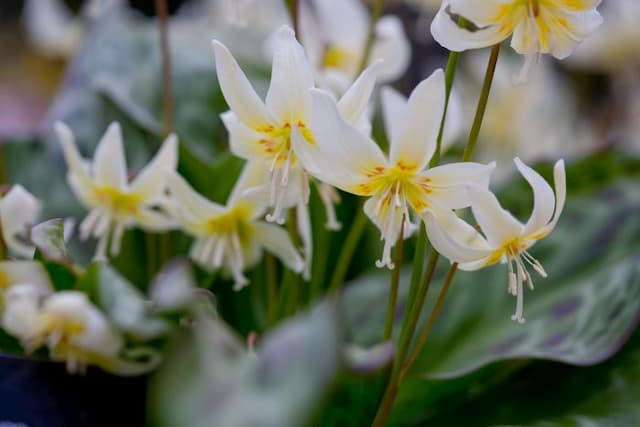Crown imperial 'Rubra Maxima' Fritillaria imperialis 'Rubra Maxima'

ABOUT
'Rubra Maxima' is a deciduous bulbous perennial, to 1.1m tall, with lance-shaped, glossy green leaves borne in whorls on the sturdy stem. In spring, umbels of nodding, orange-red flowers with darker veining are borne at the top of each stem and crowned with showy, leaf-like bracts
About this plant
 Names
NamesFamily
Liliaceae
Synonyms
Crown Imperial, Imperial Fritillary, Kaiser's Crown
Common names
Fritillaria imperialis 'Rubra Maxima'.
 Characteristics
CharacteristicsLife cycle
Perennials
Foliage type
Deciduous
Color of leaves
Green
Flower color
Orange-red
Height
3 feet (0.91 meters)
Spread
1 foot (0.30 meters)
Plant type
Bulb
Hardiness zones
5
Native area
Middle East
Benefits
 General Benefits
General Benefits- Aesthetic appeal: The plant features striking red-orange flowers that add a bold pop of color to any garden.
- Spring blooming: It flowers in the spring, providing early seasonal interest after a long winter.
- Height variety: With stems that can reach up to 1 meter, it adds vertical diversity to planting schemes.
- Architectural form: The plant has a unique shape with a crown of leaves atop the flower stem, making it a focal point in garden designs.
- Wildlife attraction: The blooms can attract pollinators like bees, which are beneficial for the garden ecosystem.
- Low maintenance: Once established, it requires minimal care, making it ideal for gardeners looking for low-effort plants.
- Perennial growth: As a perennial, it will return each year, which can be more cost-effective than planting annuals.
- Drought tolerance: Once established, it can tolerate periods of dryness, which is helpful in water-conscious gardening.
 Medical Properties
Medical PropertiesThis plant is not used for medical purposes.
 Air-purifying Qualities
Air-purifying QualitiesThis plant is not specifically known for air purifying qualities.
 Other Uses
Other Uses- Crown Imperial bulbs have been used to repel moles and voles in gardens, due to their skunk-like smell.
- The plant’s tall and prominent structure makes it an ideal focal point in floral arrangements and ornamental displays.
- Used as a teaching tool in botany and horticulture to exemplify bulbous plant growth and propagation.
- The plant's impressively tall stalk and pendant flowers are sometimes used as inspiration by artists and designers for motifs and patterns.
- In landscape designing, Crown Imperials are planted to create a vertical accent among lower-growing plants.
- It's occasionally used in perfumery as an earthy background note, although it's not a common ingredient due to its strong scent.
- Crown Imperials are planted on graves in some regions as a symbol of majesty and power, reflecting the beliefs behind its name and appearance.
- Photographers often use the striking appearance of Crown Imperials for practicing macro and close-up photography techniques.
- In areas with suitable climates, Crown Imperials are used in public spaces and parks to provide seasonal interest and naturalize settings.
- Hobbyists use dried stalks of Crown Imperial plants for crafting and creating rustic decorations.
Interesting Facts
 Feng Shui
Feng ShuiThe Crown Imperial is not used in Feng Shui practice.
 Zodiac Sign Compitability
Zodiac Sign CompitabilityThe Crown Imperial is not used in astrology practice.
 Plant Symbolism
Plant Symbolism- Royalty: Often referred to as Crown Imperial, the Fritillaria imperialis 'Rubra Maxima' bears a striking crown-like tuft of leaves atop the flower, symbolizing nobility and majesty.
- Power: With its commanding height and bold, vibrant color, the plant stands as a symbol of power and authority.
- Pride: The prominent and lofty position of the bloom is often associated with pride and vanity in the floral language.
- Resilience: Being a hardy perennial that returns each year, it represents resilience and the ability to overcome adversity.
 Water
WaterCrown imperials require consistent moisture during the spring growing season but do not like to be overwatered. They should be watered deeply once a week with about 1 gallon of water, allowing the soil to dry out slightly between waterings. It's crucial to avoid waterlogged conditions as this can lead to bulb rot. Increase watering if there are extended periods of hot and dry weather. During the dormant season in summer after the leaves die back, reduce watering significantly to mimic their natural habitat conditions.
 Light
LightCrown imperials thrive best in full sun to partial shade conditions. They should be planted in a spot that receives at least 6 hours of direct sunlight each day. An ideal spot would be one that is sheltered from strong winds but still gets adequate light, as too much shade can cause the plants to grow poorly and produce fewer flowers.
 Temperature
TemperatureCrown imperials are hardy in zones 5 through 9, tolerating winter cold down to temperatures of about -20°F. They prefer a cool to mild climate with temperatures ranging ideally between 50°F and 70°F during their growing season. During their dormant period in the summer, they can withstand higher temperatures as long as they are not excessively hot and dry.
 Pruning
PruningPruning of crown imperial plants is primarily for removing spent flower stems to tidy up the plant after blooming and to prevent seed formation, which can divert energy from the bulb. Cut the stem close to the ground level when the flowers have faded, usually in late spring. Apart from this annual pruning, little to no further pruning is necessary unless removing damaged or diseased foliage.
 Cleaning
CleaningAs needed
 Soil
SoilCrown Imperial requires a well-draining soil mix with a slightly acidic to neutral pH of 6.0-7.0. A mixture of loam, sand, and compost is ideal for ensuring good drainage and fertility.
 Repotting
RepottingCrown Imperial bulbs should be repotted every three to five years, ensuring the soil is refreshed and the bulbs are not overcrowded.
 Humidity & Misting
Humidity & MistingCrown Imperial thrives best in moderate humidity conditions; it does not require high humidity environments.
 Suitable locations
Suitable locationsIndoor
Place Crown Imperial in a bright spot, ensuring cool temps and good air flow.
Outdoor
Plant in well-drained soil, full sun to partial shade, protect from strong winds.
Hardiness zone
5-9 USDA
 Life cycle
Life cycleThe Fritillaria imperialis 'Rubra Maxima', commonly known as Crown Imperial, begins its cycle when a bulb is planted in the ground, usually during the autumn months. As winter passes, it enters a period of dormancy where underground development occurs. With the onset of spring, the bulb sends up a sturdy stem, leaves, and a crown of red, bell-shaped flowers that give it its reputation as a striking garden specimen. After flowering in spring, the plant's foliage dies back, and the bulb enters a summer dormancy phase, conserving energy for the next growth cycle. In this phase, the bulb can be left in the ground or be dug up, divided, and replanted to propagate new plants. The bulb re-emerges annually from its dormant state, completing its perennial life cycle.
 Propogation
PropogationPropogation time
Spring
The Crown Imperial Fritillaria, known as Fritillaria imperialis 'Rubra Maxima', is typically propagated by bulb division. This is best done in the late summer to early fall, after the foliage has died back and the bulb is dormant. To propagate, carefully dig up the parent bulb and gently separate the smaller bulblets that have formed around its base. These bulblets can be replanted immediately, ensuring they are planted at a depth three times their height; for a 2-inch (5 centimeters) bulblet, plant at a depth of 6 inches (15 centimeters). The separated bulblets will take a few years to reach flowering size, but once they do, they will produce the same striking, bell-shaped, reddish-orange flowers that make this plant a garden favorite.









